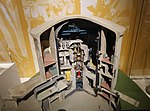The Tank Museum

The Tank Museum (previously The Bovington Tank Museum) is a collection of armoured fighting vehicles at Bovington Camp in Dorset, South West England. It is about 1 mile (1.6 km) north of the village of Wool and 12 miles (19 km) west of the major port of Poole. The collection traces the history of the tank. With almost 300 vehicles on exhibition from 26 countries it is the largest collection of tanks and the third largest collection of armoured vehicles in the world. It includes Tiger 131, the only working example of a German Tiger I tank, and a British First World War Mark I, the world's oldest surviving combat tank. It is the museum of the Royal Tank Regiment and the Royal Armoured Corps and is a registered charity.
Excerpt from the Wikipedia article The Tank Museum (License: CC BY-SA 3.0, Authors, Images).The Tank Museum
King George V Road,
Geographical coordinates (GPS) Address Phone number Website External links Nearby Places Show on map
Geographical coordinates (GPS)
| Latitude | Longitude |
|---|---|
| N 50.695194 ° | E -2.243611 ° |
Address
The Tank Museum
King George V Road
BH20 6JG , Wool
England, United Kingdom
Open on Google Maps









